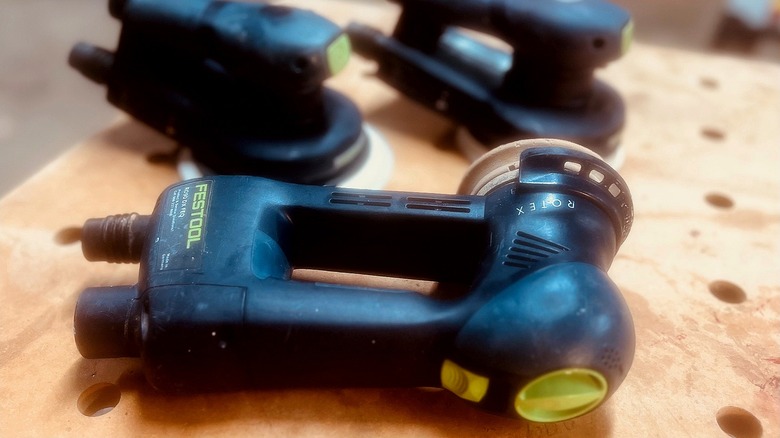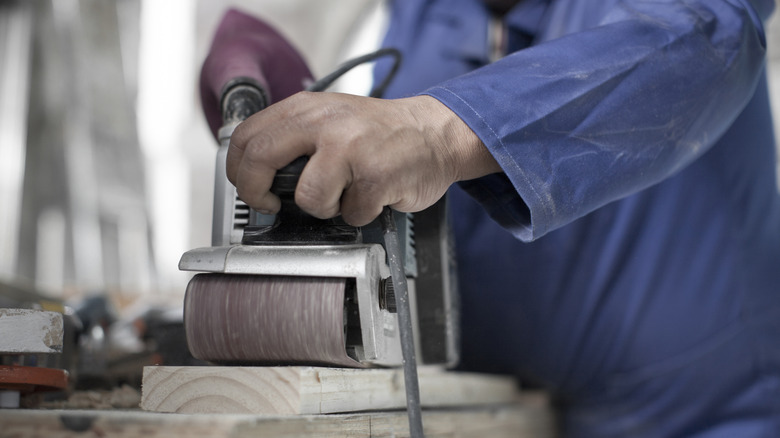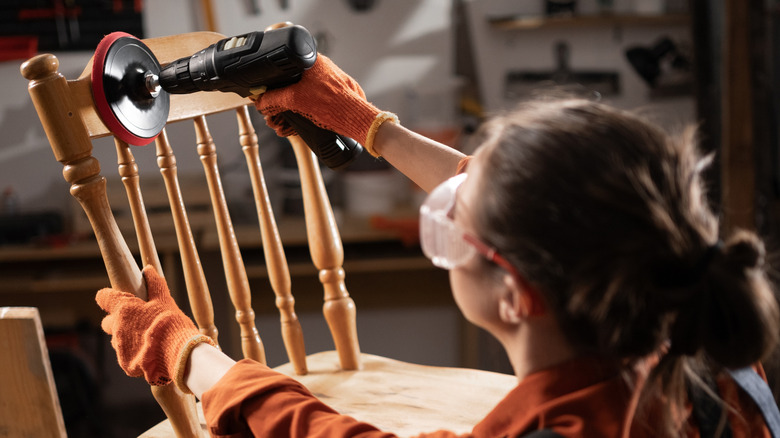The Gritty Truth About Choosing Sanders, From A Master Woodworker
Who could've predicted that my magnum opus, as a professional woodworker, would be about handheld sanders? Alas, it seems fitting somehow. After all, it's easy for someone just learning about handheld sanders to get confused. It's a common question: Which sander would be right for which project I'm doing — does it matter? And for that matter, why would one RO sander cost $50 bucks and another $500?
Given my experience, I have a lot to share regarding what sander is best used for which task. Because no, you can't just grab any sander and give it a go (presuming you want nice results, anyhow). With that said, let me start with some ground rules. First off, I'm going to focus on handheld sanders and leave stationary sanders for another time. In addition, I'll not be talking about pneumatic sanders. Why? Frankly, they're just not practical for DIYers.
As with most topics, once you learn a bit of basic information, DIYer confusion goes away pretty quickly. I've got a couple favorite types of sanders, each of which will soon become clear to you. To begin with, though, let's start with my professional opinion on which sander is the most important for you to know.
RO sanders are your go-to for most sanding jobs
Random Orbital (RO) sanders are the go-to workhorse of large professional and home workshops everywhere. Most common is the 5-inch diameter version, and it is because of that popularity that sandpaper discs for 5-inch RO sanders are very easy to find. This is especially true in the standard grits from 60-to-220-grit (but 320-to-1000-grit options are also available). The reason they are so popular is that they are so good at what they do. When used correctly, they'll sand a surface perfectly smooth, effectively and quickly, seldom leaving the pigtails that are common with sheet sanders.
The sweet spot for RO sanders is cabinet shops, home shops, doing furniture making, and other fine woodworking efforts. They are perfect for sanding raw wood. Ditto if you have a refinishing project — say, that old dresser that needs attention. In my opinion, though, whether you are a DIYer or a professional woodworker, you need an RO sander in your shop. It will handle over 60% of your sanding jobs.
One caveat is they are not the best sander for removing tons of material: For that job, look to a belt sander. The most popular RO sanders for the home have hook-and-loop plenums (the flat part of the sander that the sandpaper sticks to) which makes changing grits a snap. Another reason for their popularity is that dust control is built into these machines, especially as the models get more expensive. Combine a shop vacuum with a high-quality RO sander, outfitted with sandpaper discs designed to aid dust extraction, and the combination reduces airborne dust to a remarkable degree.
Belt sanders are your second most important tool
The second most important type of sander, in my book, is the handheld belt sander. Belt sanders are perfect for removing a lot of material in a short amount of time. The good ones are powerful and well-balanced. The two most common models are identified by the size of their sanding belts: 3" x 21" and 4" x 24". I'd stay away from other sizes, as it may be hard to find the sanding belts when you need them.
The two sizes are very similar tools, so I recommend the 4 x 24 machine, as it removes more material more quickly. If you are a smaller-framed person, the 4 x 24 may seem too heavy for you: In that case go with the 3 x 21. Smoothing rough or distressed lumber is right up a belt sander's alley (say, you are sanding dimension lumber for an outdoor project). Or perhaps you're doing a refinishing project, and you want to sand it down to raw wood. In that case, grab your belt sander, some 60-grit paper, and get busy.
As for which belt sander to purchase? Here are two pieces of advice: first, buy a well-known brand. These sanders will last for decades if you buy a quality version. And second, I recommend buying a corded model rather than a cordless version. They will generally have more power, will cost less, and I can't remember ever thinking I wanted a cordless version when using mine. Overall, by combining an RO sander and a 4 x 24 belt sander, you will cover 90% of your sanding needs.
Sheet sanders are an old-school champion (largely usurped by RO sanders)
Sheet sanders basically come in two sizes: ¼-sheet and ½-sheet. The sheet being referenced here is the standard 9-inch by 11-inch sandpaper ubiquitous in the market. You will occasionally find ¼-sheet sanders called palm sanders and they are more popular these days than the ½-sheet machines. A couple of decades ago, before the RO sander became affordable on the market, the ½-sheet sander was the main finishing sander in most shops. Nowadays, they are much less popular.
Both sizes are "orbital" in that they have an eccentric driver creating the vibrations which sand the wood. Some people call then "jitterbug" sanders because that orbital movement will make them dance across a surface if you are not holding onto them. One downside to that orbital movement is it tends to create pigtails (disfiguring curly cue marks). It is up to the user to move the sanders evenly and smoothly to avoid those flaws. They also do not remove material as effectively as the RO — in my opinion, they kind of just tickle the wood.
Is there anything to recommend about these sanders? Well, their great advantage is that they use those easy to source sheets of sandpaper. And those sheets come in a huge variety of types of grits, which is attached to the tool with built-in clamps on the plenum. As you might have inferred, I am not a fan of sheet sanders, but many woodworkers I know swear by them. Take from that what you will.
Detail sanders are best used for the finer details
If between an RO and belt sander you can do 90% of sanding tasks, what is the other 10% about? Details. Or more specifically, I'm talking about those small, hard-to-reach areas that still need to be sanded smooth. Think intricate carvings or corners, round chair legs, between balusters, or decorative spindles. Detail-sanders have triangular or spade-shaped plenums and are primarily orbital sanders with the limits that orbital sanders entail. There are a couple main types: Those with a barrel handle — with the sanding head mounted perpendicular to the handle — and those that resemble a ¼ sheet palm sander. In fact, manufacturers will say that you can use them as a palm sander, which it true. But that ignores the most salient feature of a ¼ sheet sander: That you can make use of regular sandpaper.
With detail sanders, you need to purchase specially shaped sandpaper to match the sander. All of the detail sanders I've used have hook and loop plenums. I find the specialty sandpaper annoying to buy, but I love detail-sanders when I need them.
If you are thinking of buying a detail sander, once again I recommend a well-known brand, mostly because you can have some confidence that you will be able to buy sandpaper for the machine for years to come. That said, as far as costs go, don't buy the Cadilac of detail-sanders. Go for an inexpensive corded version of a name brand, because again, you are only using it for 10% of your sanding.
Finally, let's look at specialty sanding accessories
The last category of power sanders to consider are what I'll call specialty sanders. These are sanders that get to areas that typical detail sanders can't reach. To name a few: Mini-belt sanders using a ½-wide belt, sanding discs at the end of Dremel type rotary tools, and sanding accessories that attach to your handheld drill.
I've found that I usually only purchase this type of sanders for a specific purpose — often for just one job. Believe me, all of these specialty sanding options can be real lifesavers when you really need them. Sanding small flat areas between the decorative slats of a table, sanding the curved surface of a chair's crest rail, sanding the ogee-shaped decorative edge of an antique dresser... you get the idea. But if you don't have a specific use, they just sit on a shelf gathering dust, so don't bother getting one until you have a specific job for it.
And so, I wrap up my opus with one more piece of advice: With sanders, as with nearly everything, don't let the perfect get in the way of the good. If you have a sander, you're happy with it, and it serves your purposes, good on you. But if you are new to power sanders, looking to upgrade, or are unhappy with what you have, I hope this guide will be helpful to you.





